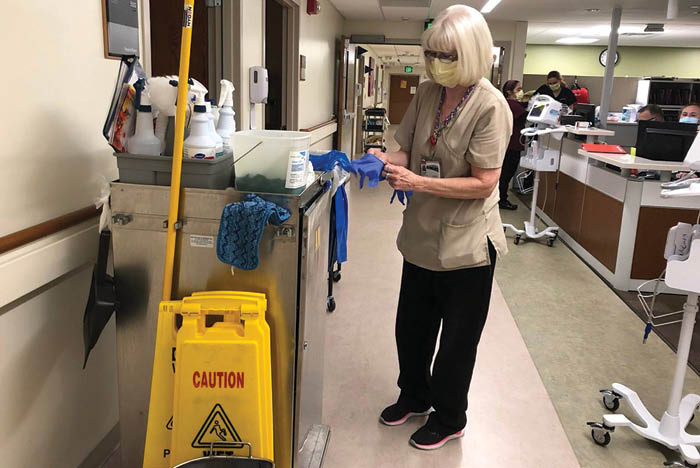EVS workers fighting on the front lines

Margaret Waggett says she likes to reassure patients during the COVID-19 outbreak that she is there for them if they need anything.
Image courtesy of UCHealth
Although their faces may not be the ones pictured on nightly newscasts, Rayon Muir, a nurse at Novant Health Presbyterian Medical Center, Charlotte, N.C., says the hospital’s environmental services (EVS) team has been critical in the mission to limit the spread of COVID-19.
“Everything they do is part of infection control,” he says. “They’re a vital part of the operation. They have a big impact on patient care.”
The team of 70 begins its first shift at 7 a.m. in a socially distanced huddle to walk through patient reviews and the day’s objectives. During the pandemic, the team has stuck to a strict protocol for COVID-19 rooms.
Once a patient has been discharged, the workers don extra protective gear for a vigorous terminal clean. First, the room is misted with a deep-cleaning chemical to kill any virus. The crew goes in next to disinfect walls and floors, and strip linens. The team keeps things efficient and moving by operating in a clockwise rotation, which also helps to ensure nothing is missed.
During this pandemic, well-established protocols such as these have been one of the saving graces in health care operations.
Willie Nash, executive director of environmental services at UCHealth Memorial Hospital Central, Colorado Springs, Colo., says that although COVID-19 is new, EVS teams can use tried-and-true practices.
“We clean C. diff, we clean MRSA, we clean all the airborne things every single day, and we do it diligently,’’ Nash says. “We just explained to our employees that this is no different than any other airborne, and this is no different procedure than any other day. On an ordinary day, we wear gloves, we wear masks, we wear gowns to protect ourselves. The only difference is we don’t know what this is.’’
His team of 146 EVS technicians goes through a two-step process using the disinfectant Virex. EVS professionals wipe down every inch of the room and everything in the room, then wait 10 minutes for the disinfectant to dry and repeat. When it came time for the team to clean the first room where a patient positive for COVID-19 was cared for, Nash led by example and didn’t hesitate to join Margaret Waggett, an EVS worker for nearly 15 years at the hospital, to don protective equipment and thoroughly clean and sterilize the room.
“It’s given them that safety net — that comfort — and if we continue to take care of ourselves the way that we are supposed to take care of ourselves, this is nothing more than a tough virus,” Nash says. “It’s no different than any other virus that we fight in the hospital; it’s just our unknown.”


